Contxto – It doesn’t take more than a day in Mexico City, Bogota, or Lima to realize that Latin America has a serious chronic traffic illness. It is for that reason that micro-mobility offered the region a new opportunity; a new way for Latin Americans to move around.
Most cities in the region aren’t well suited to pedestrians. In fact, due to precarious infrastructure, often driving or public transport are the only ways of reaching even the shortest distances.
How could we forget Lord Banqueta and his rant about the lack of sidewalks in one of Mexico’s wealthiest localities, San Pedro Garza García?
That’s not the exception. It’s the rule.
This same city infrastructure is a huge problem for last-mile mobility options, but there are other benefits to the services.
However, while the product clearly made sense, the business model has ever since been questioned. Venture capital usage subsidies, unsustainable unit economics related to the potential revenue versus wearing out of the units, and now, Covid-19, have all taken a huge blow at scooter companies.
Will this be the end or could this be the start of something new? Let me tell you what I think…
The mobility market
According to the UN, Latin America is the world’s most urbanized region. It is expected that 90 percent of the regional population will live in cities by 2050. Even today, there are 55 cities with more than one million inhabitants. Yet, despite the increased demand in city life, its delivery of goods and services is still very unsatisfactory.
Out of the 15 cities with the worst traffic congestions, four of them are Latin American. Kudos to Bogotá, Lima, Mexico City, and Recife!
Sometimes, it’s not even the fact that public transport can be a potentially dangerous focus of contagion, but it’s nonexistent.
Bogotá, for instance, Latin America’s most congested city, has no subway service. Whether this is cause or consequence to its high vehicular density is a topic for another paper, but the conclusion is the same: Something needs to change.
Interestingly enough, despite the lack of a subway, Bogotá decided it was time to add 76 kilometers of bike lanes across the city to reduce crowding of other transport mobility options during the sanitary crisis.
The answer: There is a market for micro-mobility
Last year’s McKinsey report stated that their base-case model for the global micro-mobility quarter could consume around 8 percent of the total mobility market. This puts the economics at a US$300 billion market only for the US by 2030
So, if you question whether there’s still a market for micro-mobility, I believe the answer is yes, there is both consumer and investor appetite for these products.
Although a significant share (68 percent) of passenger travel in Latam cities is on public transit or shared systems (Estupiñan et al. 2018), the supply of high-quality public transport has not kept pace with the growth in transport demand (IDB 2013).
Investors observe this fact too. Indeed, from 2016 up until February 2020, mobility startups raised an aggregated US$7.7 billion. According to Mobility Foresights, US$5 billion were raised by bike companies and the remaining by scooter startups.
Source: Self-elaboration using Mobility Foresights data.
Social distancing is a hoot for the scoot
As social distancing becomes the norm, crowds fade away (or at least they should). Public transportation is now a “necessary evil” for people to move around for essential activities in their daily lives.
The problem that it poses is obviously the increased probability of contagion due to large agglomerations of people. Micro-mobility then becomes a viable alternative to public transportation. For this reason, individual and affordable vehicles such as scooters and e-bikes will not only remain in the market, but thrive because of the new conditions.
The market shifted from being a niche market for casual users and amused tourists by broadening its user base to those who don’t only enjoy it but need it. It turned from a “nice to have” into a must-have product.
Product-market-conditions fit
Let’s not forget Mexico’s contender, Grin, did in fact reach 10 million rides in a little over a year of operations. Something hard to define without mentioning product-market fit.
Interestingly enough, the pace of achievements for Lime and Bird was very similar, meaning they both reached 10 million rides by their 12th and 14th months of operations, respectively.
Government-imposed social restrictions brought Grin to the edge. They rendered the company unable to generate revenue nor to maintain its high operation costs, including salaries all across the company.
Thus, Grow, Grin’s Mexican-Brazilian parent company, has practically come to an end. Now, while Grin has recently imploded, it doesn’t mean that the future of scooter ends with it.
In fact, while the current sanitary conditions started as a major setback to the industry, it could be the strongest force to boost its growth under the so-called “new normality” (I’m getting tired of that term, but it’s practical).
A (lack of) unit economics
Ever since the scooter pioneers, Bird and Lime, were founded back in 2017, the tech industry has questioned the viability of its business model. A system that charged users on a per-ride basis, aiming to defer the cost of the scooter among several shared usages.
The problem that many pointed out was that scooters wore out before they were able to make a profit.
Many turned to venture capital as a “grow now, profit later” business model. The problem was that contrary to other business models that can benefit from this strategy—via embedded network effects and economies of scale—, scooters could not.
Fast forward three years and we found out that once venture money had dried up, scooter companies’ patchy business model came back to haunt them.
The problem with scooter companies is that they have high variable costs that do not allow them to scale margins as easily as non-hardware companies, including:
- Payment gateway fees per ride
- Depreciation and wearing out per scooter
- Taxes
- Manufacturing costs
- General overheads
Since each scooter generates US$3.65 in revenue per ride, subtract all those operational costs, and that leaves about US$0.70 per ride, or a 19 percent gross profit margin.
The battle against cost of goods sold
In a race to outbid other companies through the per-ride model, Grow did try to lessen its variable costs through several initiatives.
First, it bought a payment processor company called Flinto, in order to reduce commissions and fees paid to gateways.
Also, if scooters are manufactured abroad, there’s also a cost of goods sold per each unit imported to the local markets. So, last year, Grow announced its plans to reduce Chinese exports of scooters by opening their own factory in Brazil.
The market is there, the product seems to have traction, the model is what is still yet to be improved. What other alternatives are there? Is it going to be a private company providing these services?
Here’s a great video summary of scooter companies!
The plausible futures for micro-mobility
The potential outcomes within this industry, shaken to its core by the pandemic, are uncertain. Who knows, perhaps it won’t even be a startup that ends up dominating the market after all. Maybe it is not about shifting monetization and pricing strategies, but something quite different.
Here are a couple of alternative futures:
Cheaper manufacturing and higher prices
- “I swear I can change, trust me!”
The average cost of an electric scooter ranges anywhere from US$250 to US$500, which gives us an idea as to why breaking even on a per-unit basis could take very long—or not even happen at all due to theft, vandalism, or accidents. According to McKinsey, on average a scooter unit takes four months to break even.
Reducing the cost of production could effectively reduce the payback period per vehicle, making it a more sustainable alternative. Increased prices could also help maintain these services operating at optimal levels (with the respective reduction in demand).
The problem with this approach is that it isn’t targeting a potential root-problem, but marginally improving an existing issue. This solution implies that the industry is okay as is, and it’s just a business or operating issue waiting to be solved.
Subscription model
- “The easy way out”
In one of their last gasps of breath, Grin launched a new product to counter the concern surrounding shared mobility, Grin4U.
Covid-19 can be found both in the air and on surfaces. Crowded buses pose the problem of finding the virus in both ways, shared scooters eliminate the risk of contagion by air, but still struggle with contaminated surfaces on the scooter handles.
Its subscription service was launched with this in mind, “renting” the scooter to a certain person for a specified timeframe, effectively eliminating all concerns from switching hands among many people.
A new subscription service could be another alternative to counteract, not only worries around pollution but also to improve the business itself. Unit economics can be improved because users’ aren’t paying for the use but for the time opportunity of usage.
However, unit economics are tricky, because it all depends on the pricing.
The main problem with a subscription-based hardware business is the unpredictability of usage. According to Fintonic, the average Grin ticket is US$1.5 and The Information reports an average scooter use of five times per day.
This results in US$7.5 of revenue per scooter, per day. If they plan to charge a subscription of US$40 per month, this would result in US$1.3 of daily revenue and unlimited daily usage. Will subscribers be scooting far less than five times daily? Otherwise, the math doesn’t add up.
Consumer-owned scooters
- “Like Apple’s hardware ft. software model”
People won’t rent scooters on a monthly basis; they won’t pay on a per-ride basis either. They will rather buy the scooter themselves!
This is something that was already happening within a small subsection of the market. The clear rebuttal is that bringing the scooter everywhere, rather than being able to leave it randomly in the street is a burden not many people would like to handle.
Government financed scooters
- “Too good to be private?”
Publicly owned micro-mobility services aren’t something new. Local and municipal governments all around the world were already experimenting with their very own alternatives (some of them even before the private options came out).
In fact, this was an important reason why some cities had stricter rules against private scooter companies. They were already exploring the market themselves.
Public alternatives reduce the pressure of operations having to reach 10x VC-required returns, but could also mean there are fewer incentives to improve the product and service.
No scooters at all
- “Back to square one”
Could we go back to the start? Walking, buses, cars, and bikes? What makes a scooter more viable than a regular bike?
So, where are we going?
2019 was the year scooters blew out of proportion. 2020’s proportions have gone back to normal.
With Grow (mostly) out of the game, and Lime and Bird retreating from most of their Latin American operations to focus on their prime economies, there’s a gap in the market waiting to be properly addressed.
Could this be an unprecedented situation of a large market opportunity, solid product-market fit, but unviable supply due to weak revenue and cost structure?
Could this be the opportunity for governments to take over the industry and subsidize it themselves as a public service?
Should public expenditure consider micro-mobility solutions as part of public transportation? Was this industry born to be a public-private partnership (PPP)?
In summary
The problems are there:
- Latin America has some of the worst traffic congestion worldwide
- The quality of public transport isn’t questionable; it sucks
- If it wasn’t a nice option already, Covid-19 makes public transport even less so
- Owning a car or paying for private transport services isn’t only expensive, but illogical when all you need is to quickly travel six blocks
The market is there:
- There are 100 million cars in Latam (one for every five people)
- More than 50 cities in the region have implemented Bus Rapid Transit systems, moving along 16 million passengers in total every single day
- Around 200 million people across the region use public transport on a daily basis
The solution:
- Yet to be properly implemented
Related articles: Tech and startups from Mexico!
-VC






